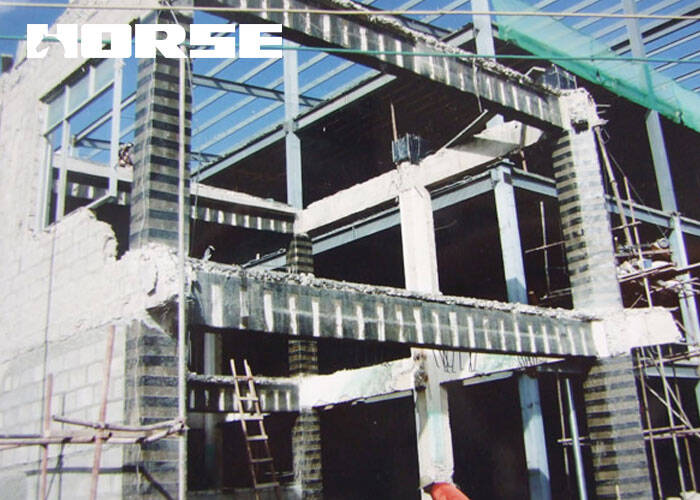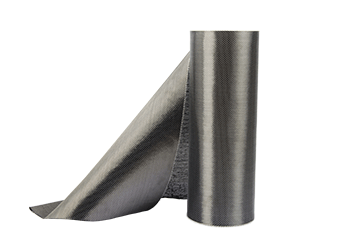Solutions
Horse Construction offers full range of structural strengthening materials with technical supports, documentation supports, products supports, project supports.
reinforced concrete column with carbon fiber CFRP

In the construction of projects, there are often cases in which the structure or components cannot meet the requirements of the current design codes due to design errors, improper construction or changes in use functions. Once this happens, to ensure that the relevant structures or components can continue to be used safely and normally, certain measures must be taken for reinforcement and repair.
Carbon fiber reinforced plastic (CFRP) is a new material for strengthening concrete structures that has emerged in developed countries in the past ten years and is widely used in civil construction reinforcement projects. Its excellent mechanical properties have been called "the new star of structural reinforcement" in the engineering field. The CFRP reinforced reinforced concrete column has the characteristics of simple construction, strong corrosion resistance, good restraint effect, and basically does not require maintenance. The reinforcement technology is briefly introduced below.
Characteristics of carbon fiber reinforced plastic (CFRP)
1) The density is small, 1/6 of ordinary steel,
2) High strength, the tensile strength is about 4-6 times that of ordinary steel bars;
3) Good corrosion resistance, and the strength is not affected by acid and alkali corrosive media;
4) It is a non-magnetic material, which does not affect the propagation of electromagnetic signals;
5) Excellent fatigue resistance, fatigue life is generally higher than steel;
6) The coefficient of temperature change is equivalent to that of concrete, the modulus of elasticity is similar to that of steel, and the ultimate elongation is 1%.
Reinforced concrete column CFRP strengthening principle
When reinforced concrete columns are subjected to axial pressure, the members are caused by lateral expansion with very small limit values. For example, a lateral constraint can be created around the member to prevent this lateral expansion of the compressed member, thereby improving the compressive bearing capacity and deformability of the member. Carbon fiber CFRP-reinforced reinforced concrete columns are binding between the column concrete and the CFRP reinforced belt, and the interaction between them is called the interface constraint stress. Due to the constrained stress of the lateral interface, the core concrete in the plastic zone is in a three-dimensional stress state. Compared with the unidirectional stress state, the ultimate compressive strain and bearing capacity of the concrete will increase. In the case that the bending bearing capacity of the column does not drop significantly, the effect of instability is not considered, and the reinforced concrete column has greater ductility and energy dissipation capacity after reinforcement.
Stress distribution of reinforced concrete column under CFRP wrap
1 Due to the lateral restraint of CFRP on the reinforced concrete column, the CFRP forms an axial tensile stress, and the bending resistance of CFRP is extremely weak (generally not considered). The ultimate ultimate axial compressive strength of the rectangular column under the CFRP wrapping constraint is greatly reduced compared to that of the column, mainly due to the uneven lateral constraint stress. The central lateral restraint of the rectangular column side is weak, and the lateral stress concentration restraint at the corner is relatively large. Only when the lateral plastic deformation of the column side occurs, the transverse restraint stress of CFRP on the reinforced concrete column can increase rapidly.
2 Since the restraint of CFRP on the reinforced concrete column is the interface restraint, only when the concrete expands laterally outwards (plastic deformation occurs) CFRP can produce restraining stress on the concrete. Therefore, the column ring-wrapped CFRP exhibits a two-stage force process when under load. In the first stage, the axial compressive stress of the concrete column is small, the lateral deformation is small, and the CFRP stress is small. In the second stage, as the load increases, the deformation of the column concrete column increases, the CFRP hoop stress increases significantly, and the hoop restraint force increases rapidly, until the CFRP reaches its ultimate tensile strain and breaks. The increase of the restraint stress and strain value of CFRP on concrete is related to the specification, paste form, and number of layers of CFRP material used, and should be determined through experiments.
The scope of application of CFRP reinforced reinforced concrete columns
CFRP-reinforced reinforced concrete columns are suitable for cylindrical or small cross-section rectangular columns (the side length of the section is generally less than 800mm), and can greatly improve the axial bearing capacity of the reinforced concrete column when it is not unstable. The prerequisite for reinforcement is that the core concrete of the component has not been damaged and still has a certain bearing and deformation capacity.
Main points of reinforcement construction of CFRP reinforced reinforced concrete columns
1 Unloading before reinforcement of reinforced concrete columns is often overlooked. When a concrete component is wrapped with CFRP under load, after the wrapped CFRP has strain relative to the surface of the concrete column, it often happens that the CFRP has not been broken and the concrete column has been crushed. Therefore, the outsourcing of CFRP on concrete members under load reduces the reinforcement effect of CFRP and cannot fully exert the high-strength tensile properties of CFRP.
2 The radius of the corner chamfer of the rectangular column shall not be less than 20mm, and the column side is best modified to be convex to reduce the concentrated stress of CFRP at the corner. Many tests have shown that even so, the damage of CFRP still occurs in the corner.
3 The repair of the surface of concrete members is extremely important, which directly affects the effect of CFRP on the lateral restraint of concrete.
You can find anything here you are in need of, have a trust trying on these products, you will find the big difference after that.

High strength, unidirectional carbon fiber wrap pre-saturated to form a carbon fiber reinforced polymer (CFRP) wrap used to strengthen structural concrete elements.

High strength, unidirectional carbon fiber fabric pre-saturated to form a carbon fiber reinforced polymer (CFRP) fabric used to strengthen structural concrete elements.

High strength, unidirectional carbon fiber sheet pre-saturated to form a carbon fiber reinforced polymer (CFRP) sheet used to strengthen structural concrete elements.